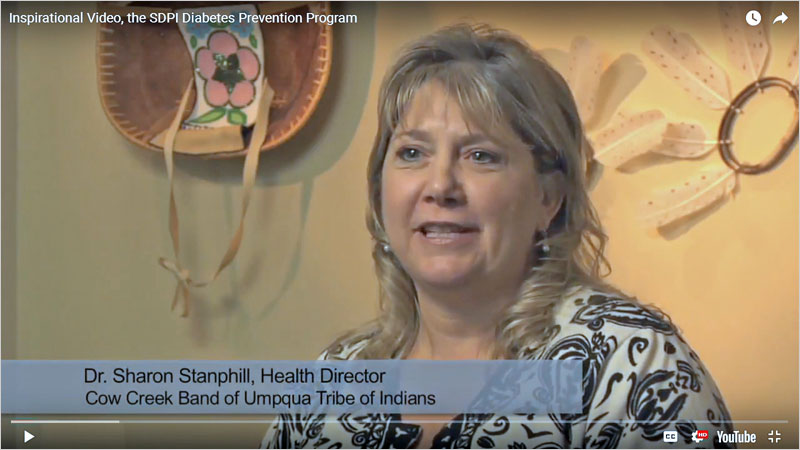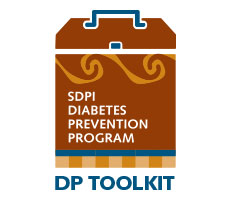Diabetes Prevention Program Toolkit
Archived: This Page Is No Longer Being Updated
This webpage is archived for historical purposes and is no longer being maintained or updated.
Module 1: Getting Started
Welcome!
The National Institute of Diabetes and Digestive and Kidney Disease (NIDDK) Diabetes Prevention Program (DPP) research study showed that a small amount of weight loss, achieved through lifestyle changes, could prevent the onset of type 2 diabetes in diverse populations – including American Indian people. Even more striking, a lifestyle intervention was more effective than medication in preventing or delaying the onset of type 2 diabetes.
The DPP program has already been successfully applied in American Indian/Alaska Native (AI/AN) communities through the Special Diabetes Program for Indian (SDPI) Diabetes Prevention (DP) grant program. As in the NIDDK DPP, many SDPI participants lost weight and reduced their diabetes risk by increasing their level of physical activity and eating healthier foods.
It is the hope that other AI/AN communities will implement their own innovative diabetes prevention strategies based on the NIDDK DPP to reduce diabetes risk and create healthier futures for people in their community. The modules in this toolkit will provide keys to success and lessons learned from 38 SDPI DP grant programs as they used the NIDDK DPP to meet the needs of their communities while incorporating their traditions and cultures.
Getting Started
It takes time to build a program that engages the community and establishes community ownership. Input from stakeholders, such as Tribal and community leaders, local clinic staff, and participants can help to improve the success of your program. When you're ready, develop a plan.
- Determine the mission of your DPP program and use it to help guide decisions about priorities, actions, and responsibilities.
- Learn about the culture of the Tribe(s) you serve and find ways to incorporate cultural elements and values into your program.
- Assess the effectiveness of your DPP program often.
- Use this toolkit and other related DPP resources, particularly the Centers for Disease Control and Prevention's (CDC) National Diabetes Prevention Program, to help you identify strategies to overcome barriers.
Keys to Success
The SDPI DP Programs found that gaining support from Tribal, clinical, and community leadership during the program development stage helped contribute to the success of their DPP program. Encourage community interaction and involvement when planning your new program.
- Assess and obtain Tribal and internal organization support.
- Attend Tribal meetings, give presentations, and seek input for the program.
- Consider obtaining a Tribal Resolution in support of the program.
- Identify a Tribal council member and/or official to support your program.
- Identify and create buy-in from key clinical staff from various departments within your organization. This may include: primary care providers, public health nurses (PHNs), community health representatives (CHRs), and others.
- Set up meetings with key decision makers to share the program purpose and to help in planning.
- Consider setting up a program advisory board of experts and stakeholders to provide guidance to the DPP program.
- Assess needs and identify resources.
- Define budget, location or space, and staffing needs.
- Identify financial and other resources available for the program.
- Establish strong connections with local community partners.
- Develop a referral process with community partners to recruit participants to your DPP program.
For more information on gaining support, assessing needs, and establishing partners, view resources from:
- SDPI DP Program:
- Module 1: Getting Started – Appendix (Stakeholder Support Examples)
- CDC's National Diabetes Prevention Program:
- American Medical Association and CDC:
Good communication is essential to help spread the word about your DPP program throughout the Tribal community.
- Develop messages that speak to your community.
- Incorporate local culture and traditions into messages and graphics.
- Adapt or translate materials to meet your community's needs.
- Disseminate messages through multiple communication channels such as Tribal events or festivals, newspapers or newsletters, and radio stations.
For more information on communication and promotion strategies, view resources from:
- SDPI DP Program:
- Module 1: Getting Started – Appendix (Stakeholder Support Examples)
- CDC's National Diabetes Prevention Program:
- American Medical Association and CDC:
During this stage of program development, begin to document all meetings – with team staff, other departments, stakeholders, and partners. Meeting minutes should reflect a plan of action and staff responsible for accomplishing goals.
For more information on documenting the planning process, view resources from:
- SDPI DP Program:
- Module 1: Getting Started – Appendix (Confidentiality Form Example)
- CDC's National Diabetes Prevention Program:
- American Medical Association and CDC:
Lessons Learned
Case Study: Powerful Partnerships: Redefining Community Health & Wellness
K'ima:w Medical Center Diabetes Prevention Program
Hoopa, CA
As the largest land based Tribe in California (12 square miles), the Hoopa Valley Tribe has retained many of its rich cultural traditional dances and practices. This traditional way of life is based on the semi-annual king salmon runs that still occur on the Trinity River flowing through the center of the Hoopa Valley Reservation.
"We cherish our land and our ability to still hunt, to fish with nets in the river, and to continue to gather and prepare acorns as we have done for thousands of years," stated Glenna Starritt, Diabetes Project Coordinator.
The Diabetes Prevention Program staff is committed to developing partnerships to provide activities that incorporate this rich heritage while focusing on community health issues.
Activities include: Acorn Camp, Canoe Paddle Camp, Canoe Carving Project, Fish Fair, Basket Weaving, and more. These activities all focus on nurturing healthy bodies, healthy relationships, and healthy families. "We reach beyond nutrition and exercise and address social and environmental issues that also impact the health and wellness of our community," said Glenna.




